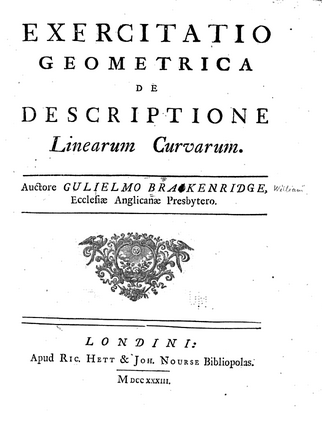William Brakenridge on:
[Wikipedia]
[Google]
[Amazon]
William Braikenridge (also Brakenridge) (c.1700–1762) was a Scottish mathematician and cleric, a Fellow of the Royal Society from 1752.
 *''Exercitatio Geometrica de Descriptione Linearum Curvarum'' (1733)
*''Proposals for lectures on the principles of mechanicks and natural philosophy, by Mr. Braikenridge: Formerly teacher of the mathematicks at Edinburgh'' (1750?)
*''A Letter from the Reverend William Brakenridge, D.D. and F.R.S. to George Lewis Scot, Esq; F. R. S. concerning the Number of Inhabitants within the London Bills of Mortality (1 January 1753)'', in ''
*''Exercitatio Geometrica de Descriptione Linearum Curvarum'' (1733)
*''Proposals for lectures on the principles of mechanicks and natural philosophy, by Mr. Braikenridge: Formerly teacher of the mathematicks at Edinburgh'' (1750?)
*''A Letter from the Reverend William Brakenridge, D.D. and F.R.S. to George Lewis Scot, Esq; F. R. S. concerning the Number of Inhabitants within the London Bills of Mortality (1 January 1753)'', in ''
CERL page
{{DEFAULTSORT:Braikenridge, William 1700 births 1762 deaths Scottish mathematicians 18th-century Scottish Episcopalian priests Fellows of the Royal Society
Life
He was son of John Braikenridge of Glasgow. s:Page:Alumni Oxoniensis (1715–1886) volume 1.djvu/169 In the 1720s he taught mathematics in Edinburgh. Braikenridge was Honorary A.M. in 1735, and D.D. in 1739, of Marischal College, when he was vicar of New Church, Isle of Wight. He was incorporated at The Queen's College, Oxford, in 1741. He became rector of St Michael Bassishaw, and from 1745 librarian of Sion College, in London.Works
In geometry the Braikenridge–Maclaurin theorem was independently discovered by Colin Maclaurin. It occasioned a priority dispute after Braikenridge published it in 1733; Stella Mills writes that, while Braikenridge may have wished to establish priority, Maclaurin rather felt slighted by the implication that he did not know theorems in the ''Exercitatio'' that he had taught for a number of years. *''Exercitatio Geometrica de Descriptione Linearum Curvarum'' (1733)
*''Proposals for lectures on the principles of mechanicks and natural philosophy, by Mr. Braikenridge: Formerly teacher of the mathematicks at Edinburgh'' (1750?)
*''A Letter from the Reverend William Brakenridge, D.D. and F.R.S. to George Lewis Scot, Esq; F. R. S. concerning the Number of Inhabitants within the London Bills of Mortality (1 January 1753)'', in ''
*''Exercitatio Geometrica de Descriptione Linearum Curvarum'' (1733)
*''Proposals for lectures on the principles of mechanicks and natural philosophy, by Mr. Braikenridge: Formerly teacher of the mathematicks at Edinburgh'' (1750?)
*''A Letter from the Reverend William Brakenridge, D.D. and F.R.S. to George Lewis Scot, Esq; F. R. S. concerning the Number of Inhabitants within the London Bills of Mortality (1 January 1753)'', in ''Philosophical Transactions
''Philosophical Transactions of the Royal Society'' is a scientific journal published by the Royal Society. In its earliest days, it was a private venture of the Royal Society's secretary. It was established in 1665, making it the first journa ...
''. This paper was topical, because parliament was considering legislation on a census and registration of vital information. Braikenridge argued, from bills of mortality, that London's population had peaked a decade earlier; a controversy arose with Richard Forster of Great Shefford
Great Shefford (or West Shefford) is an English village and Civil parishes in England, civil parish on the River Lambourn in the West Berkshire district of Berkshire. The present civil parish includes the historical parish of Little or East She ...
George Burrington
George Burrington ( ca. 1682 – 22 February 1759) was a British colonial official who served as the third and fifth governor of North Carolina from 1724 to 1725 and 1731 to 1734. He is noted for opening the lower Cape Fear region to settlement ...
also answered, in 1757. It was argued against Braikenridge that population was increasing, near the area he considered.
*'' A letter to the right honourable the earl of Macclesfield, president of the Royal society, concerning the method of constructing a table for the probabilities of life at London'' (1755)
*''A Letter to the Right Honourable Hugh Earl of Marchmont. F. R. S. concerning the Sections of a Solid, Hitherto Not Considered by Geometers; From William Brakenridge, D. D. Rector of St. Michael Bassishaw London, and F. R. S.'' (1759)
*''Sermons on Several Subjects by the Late William Brakenridge'' To which Jane Austen
Jane Austen (; 16 December 1775 – 18 July 1817) was an English novelist known primarily for her six major novels, which interpret, critique, and comment upon the British landed gentry at the end of the 18th century. Austen's plots of ...
's father, the Rev. George Austen subscribed whilst a fellow of St. John's College.
Notes
External links
CERL page
{{DEFAULTSORT:Braikenridge, William 1700 births 1762 deaths Scottish mathematicians 18th-century Scottish Episcopalian priests Fellows of the Royal Society